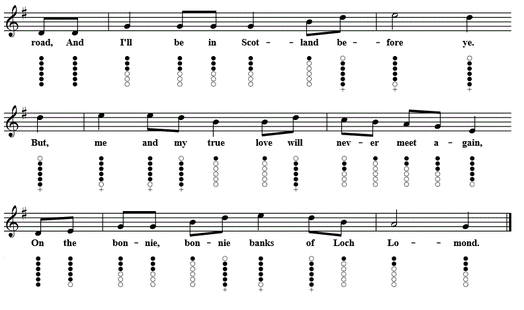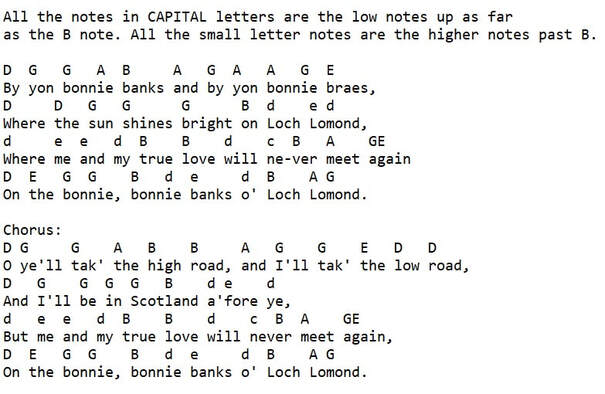Loch Lomond Tin Whistle Notes
Loch Lomond Sheet Music And Tin Whistle Notes with the flute and recorder music with finger position chart and letter notes for beginners.The Real McKenzies had great success with this song. This Scottish song uses pretty much the same notes as the Irish song ''Red Is The Rose [ sheet music ]''. Which came first, I don't know. I already made a video for Red Is The Rose tin whistle so I thought I'd use it here because it's fairly close to this song. Recently recorded by Nathan Carter and in 2019 by Ella Roberts.Loch lomond sheet music notes in Slofege do re mi format now included along with the easy to play letter notes for beginners..Loch lomond guitar tab now added including a version in CGDA tuning.

,
Below is the list of sheet music and tin whistle songs that are in my ebooks. This is the largest collection of tin whistle songs ever put together.[over 800 songs ] Including folk, pop and trad tunes plus German And French songs along with Christmas Carols.
All of the sheet music tabs have been made as easy to play as was possible.
The price of the ebooks is €7.50
All of the sheet music tabs have been made as easy to play as was possible.
The price of the ebooks is €7.50
Below is Loch Lomond letter notes for beginners. The youtube video is slightly as I'm
actually playing the song ''Red Is The Rose'' , but it's almost the same. These letter notes below
match what's in the Loch Lomond sheet music above. You can use these notes to play
on your recorder, flute, piano keyboard or tin whistle. If using the piano, remember there are no
black note keys to play as there's no # [ sharp ] or flat notes.
actually playing the song ''Red Is The Rose'' , but it's almost the same. These letter notes below
match what's in the Loch Lomond sheet music above. You can use these notes to play
on your recorder, flute, piano keyboard or tin whistle. If using the piano, remember there are no
black note keys to play as there's no # [ sharp ] or flat notes.
The song 'Loch Lomond' has captured the hearts of listeners for centuries with its haunting melody and poignant lyrics. Its enduring popularity and relevance is a testament to its powerful storytelling and its ability to evoke a sense of nostalgia, patriotism, and longing for the Scottish landscape. This thesis aims to explore the history, significance, and impact of the song 'Loch Lomond' on Scottish culture and beyond.
The origins of 'Loch Lomond' can be traced back to the 18th century, although there is no clear consensus on its exact authorship. Some argue that it was composed by a Scottish soldier returning from the Battle of Culloden in 1746, while others believe it was written by an anonymous Jacobite exile. Regardless of its author, the song's lyrics and melody were passed down through oral tradition and eventually published in the early 19th century.
At its core, 'Loch Lomond' is a love song that tells the story of two Scottish soldiers who fought in the Jacobite uprising of 1745. One soldier is condemned to death and the other is set free, leading to the famous lines 'You'll take the high road, and I'll take the low road, and I'll be in Scotland before ye.' The song's bittersweet tale of separation and loss struck a chord with many Scots, especially those who had experienced the devastating effects of war and political turmoil.
The song's popularity grew in the 19th century as it became associated with Scottish identity and nationalism. It was often sung at gatherings and events, such as Burns Suppers, where it served as a reminder of Scotland's history and culture. In the late 19th and early 20th centuries, 'Loch Lomond' was also embraced by Scottish emigrants, who sang it to remember their homeland and express their longing for their lost loved ones and way of life.
In addition to its cultural significance, 'Loch Lomond' also has a strong emotional impact on listeners. The song's haunting melody and melancholic lyrics evoke a sense of longing and nostalgia, even for those who have no connection to Scotland. Its universal themes of love, loss, and longing have made it a popular choice for artists to cover and reinterpret, from traditional Scottish folk singers to mainstream pop stars. Its enduring popularity is a testament to the song's ability to connect with people on a deeply emotional level.
Furthermore, 'Loch Lomond' has also had a significant impact on the tourism industry in Scotland. The song's romanticized depiction of the Scottish landscape, specifically the idyllic Loch Lomond, has drawn visitors from all over the world to experience the beauty and charm of Scotland for themselves. The popularity of the song has also led to the creation of various cultural events and festivals, such as the annual Loch Lomond Highland Games, which celebrate Scottish heritage and attract tourists to the region.
However, the song's enduring popularity is not without controversy. Some have criticized 'Loch Lomond' for perpetuating a romanticized and idealized version of Scotland that ignores its troubled history and present-day issues. Others have also questioned the song's authenticity and whether it truly represents the experiences of the Scottish people.
In conclusion, the song 'Loch Lomond' holds a special place in Scottish culture and beyond. Its powerful storytelling, emotional impact, and cultural significance have made it an enduring symbol of Scottish identity and heritage. Through its timeless lyrics and haunting melody, the song continues to evoke a sense of longing and nostalgia for the Scottish landscape and its people, and will likely continue to do so for generations to come
The origins of 'Loch Lomond' can be traced back to the 18th century, although there is no clear consensus on its exact authorship. Some argue that it was composed by a Scottish soldier returning from the Battle of Culloden in 1746, while others believe it was written by an anonymous Jacobite exile. Regardless of its author, the song's lyrics and melody were passed down through oral tradition and eventually published in the early 19th century.
At its core, 'Loch Lomond' is a love song that tells the story of two Scottish soldiers who fought in the Jacobite uprising of 1745. One soldier is condemned to death and the other is set free, leading to the famous lines 'You'll take the high road, and I'll take the low road, and I'll be in Scotland before ye.' The song's bittersweet tale of separation and loss struck a chord with many Scots, especially those who had experienced the devastating effects of war and political turmoil.
The song's popularity grew in the 19th century as it became associated with Scottish identity and nationalism. It was often sung at gatherings and events, such as Burns Suppers, where it served as a reminder of Scotland's history and culture. In the late 19th and early 20th centuries, 'Loch Lomond' was also embraced by Scottish emigrants, who sang it to remember their homeland and express their longing for their lost loved ones and way of life.
In addition to its cultural significance, 'Loch Lomond' also has a strong emotional impact on listeners. The song's haunting melody and melancholic lyrics evoke a sense of longing and nostalgia, even for those who have no connection to Scotland. Its universal themes of love, loss, and longing have made it a popular choice for artists to cover and reinterpret, from traditional Scottish folk singers to mainstream pop stars. Its enduring popularity is a testament to the song's ability to connect with people on a deeply emotional level.
Furthermore, 'Loch Lomond' has also had a significant impact on the tourism industry in Scotland. The song's romanticized depiction of the Scottish landscape, specifically the idyllic Loch Lomond, has drawn visitors from all over the world to experience the beauty and charm of Scotland for themselves. The popularity of the song has also led to the creation of various cultural events and festivals, such as the annual Loch Lomond Highland Games, which celebrate Scottish heritage and attract tourists to the region.
However, the song's enduring popularity is not without controversy. Some have criticized 'Loch Lomond' for perpetuating a romanticized and idealized version of Scotland that ignores its troubled history and present-day issues. Others have also questioned the song's authenticity and whether it truly represents the experiences of the Scottish people.
In conclusion, the song 'Loch Lomond' holds a special place in Scottish culture and beyond. Its powerful storytelling, emotional impact, and cultural significance have made it an enduring symbol of Scottish identity and heritage. Through its timeless lyrics and haunting melody, the song continues to evoke a sense of longing and nostalgia for the Scottish landscape and its people, and will likely continue to do so for generations to come
Below is the tenor guitar / mandola tab in CGDA tuning
Loch lomond sheet music notes in Slofege do re mi format in D Major











